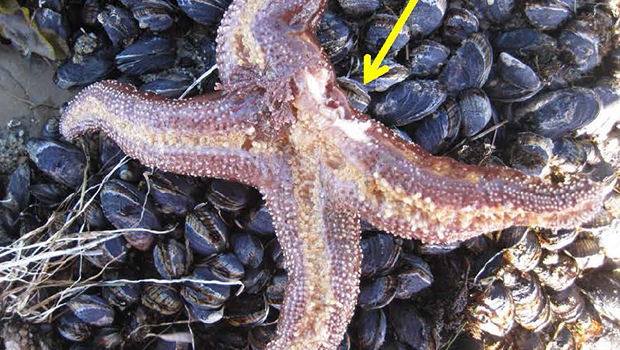Mystery disease turning starfish into "goo"
By Danielle Elliot / CBS News/ November 4, 2013
http://www.cbsnews.com/8301-205_162-57610723/mystery-disease-turning-starfish-into-goo/

A sea star with "Category 3" sea star wasting disease
has lesions on most of its body and is missing one to two arms. This sea star
is missing one arm.
/ Courtesy USCS Long Marine Lab
A record number of starfish are dying along the West Coast, as a disease turns their arms into "goo.
The animals, also known as sea stars, are falling victim to sea star wasting disease. It causes white lesions to develops along their arms, which slowly spread and cause their arms to disintegrate.
"What's happening? We don't know yet. We think it's bacterial," Pete Raimondi, chairman of the Department of Ecology and Evolutionary Biology at the University of California, Santa Cruz's Long Marine Lab, tells CBSNews.com. "We also know that it can move between species. They get a wound and the bacteria will just kind of eat the species away."
Researchers first started reporting the die-off in June. In late August, marine biologist Jonathan Martin, out for a Saturday scuba dive, noticed dead starfish that looked like they'd had their arms chopped off, he told National Geographic. He posted video footage to You Tube and photos to Facebook.
Dead sea stars have since turned up along the coast from Alaska down to Southern California. Raimondi says that the disease is likely affecting the sea star population as far south as Mexico, though researchers have not had a chance to collect data from that area.
In the past, researchers have linked sea star wasting disease outbreaks to warm ocean temperatures. The biggest die-off occurred along the coast of Southern California from 1983-1984, during an El Nino year. It caused some species to go locally extinct -- although they did eventually come back. A smaller die-off wiped out some of the population in 1997-1998, another El Nino year.
"We're not having an El Nino year this year. That's what's really troublesome about this," Raimondi added.
Until researchers can properly map the outbreak, Raimondi added, it will be difficult to determine the cause, or an underlying link between the regional outbreaks.
"I don't think there's been a spread, but it's likely that the same causal factors are contributing to these separate outbreaks," he said.
So far, the disease has killed 95 percent of certain species in some tide pools. The overall population numbers in the millions, Raimondi said, but it is troubling to see such a large percentage die off in individual tide pool. Sea stars have "profound effects on the rest of community because they eat a lot," Raimondi said, adding that in the absence of sea stars, the population of mussels -- not the edible kind -- will expand tremendously.
A similar die-off event is decimating the population of the Asterias species of starfish along the U.S. East Coast. The event started in 2011 and has effected sea stars from Maine to New Jersey.
The next big thing, Raimondi said, is to figure out what is
causing this, so that researchers can start to determine how to control the
outbreak. His lab is mapping local reports on an interactive site, as well
as updating a news feed as the outbreak continues. They are asking local divers
to post their findings to the site, in the hopes that they can start to identify
a pattern and then, eventually, a cause.
© 2013 CBS Interactive Inc. All Rights Reserved.